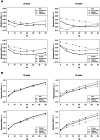Reference values of impulse oscillometric lung function indices in adults of advanced age
- PMID: 23691036
- PMCID: PMC3655177
- DOI: 10.1371/journal.pone.0063366
Reference values of impulse oscillometric lung function indices in adults of advanced age
Abstract
Background: Impulse oscillometry (IOS) is a non-demanding lung function test. Its diagnostic use may be particularly useful in patients of advanced age with physical or mental limitations unable to perform spirometry. Only few reference equations are available for Caucasians, none of them covering the old age. Here, we provide reference equations up to advanced age and compare them with currently available equations.
Methods: IOS was performed in a population-based sample of 1990 subjects, aged 45-91 years, from KORA cohorts (Augsburg, Germany). From those, 397 never-smoking, lung healthy subjects with normal spirometry were identified and sex-specific quantile regression models with age, height and body weight as predictors for respiratory system impedance, resistance, reactance, and other parameters of IOS applied.
Results: Women (n = 243) showed higher resistance values than men (n = 154), while reactance at low frequencies (up to 20 Hz) was lower (p<0.05). A significant age dependency was observed for the difference between resistance values at 5 Hz and 20 Hz (R5-R20), the integrated area of low-frequency reactance (AX), and resonant frequency (Fres) in both sexes whereas reactance at 5 Hz (X5) was age dependent only in females. In the healthy subjects (n = 397), mean differences between observed values and predictions for resistance (5 Hz and 20 Hz) and reactance (5 Hz) ranged between -1% and 5% when using the present model. In contrast, differences based on the currently applied equations (Vogel & Smidt 1994) ranged between -34% and 76%. Regarding our equations the indices were beyond the limits of normal in 8.1% to 18.6% of the entire KORA cohort (n = 1990), and in 0.7% to 9.4% with the currently applied equations.
Conclusions: Our study provides up-to-date reference equations for IOS in Caucasians aged 45 to 85 years. We suggest the use of the present equations particularly in advanced age in order to detect airway dysfunction.
Conflict of interest statement
Figures


References
-
- Dubois AB, Brody AW, Lewis DH, Burgess BF Jr (1956) Oscillation mechanics of lungs and chest in man. J Appl Physiol 8: 587–594. - PubMed
-
- Vogel J, Smidt U (1994) Impulse Oscillometry. Analysis of lung mechanics in general practice and clinic, epidemiological and experimental research. Frankfurt: PMI-Verlagsgruppe.
-
- Oostveen E, MacLeod D, Lorino H, Farre R, Hantos Z, et al. (2003) The forced oscillation technique in clinical practice: methodology, recommendations and future developments. Eur Respir J 22: 1026–1041. - PubMed
-
- Malmberg LP, Pelkonen A, Poussa T, Pohianpalo A, Haahtela T, et al. (2002) Determinants of respiratory system input impedance and bronchodilator response in healthy Finnish preschool children. Clin Physiol Funct Imaging 22: 64–71. - PubMed
Publication types
MeSH terms
LinkOut - more resources
Full Text Sources
Other Literature Sources

